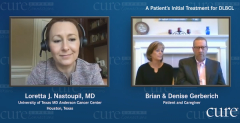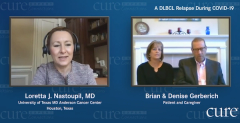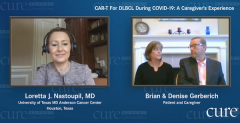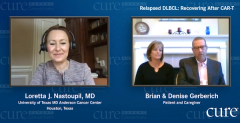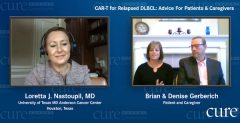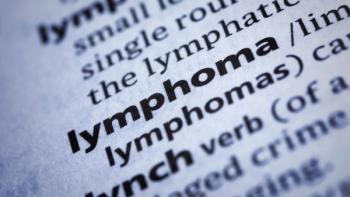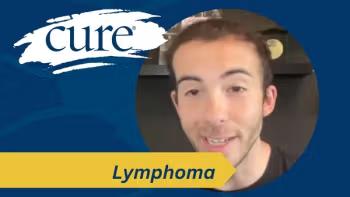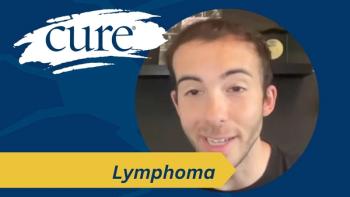
CAR-T Cell Therapy for Relapsed/Refractory DLBCL
Episodes in this series

Loretta J. Nastoupil, MD: Once you met us, do you remember what we talked about as to what the next steps might be?
Brian Gerberich: We looked at a trial and thought that it might be the way to go. We met with another doctor there who was heading up that trial and ultimately we decided, because of timing and because I had waited so long to get any kind of treatment, that we go with the CAR-T [chimeric antigen receptor-T cell therapy] as quick as we could.
Loretta J. Nastoupil, MD: For those who are listening along, Brian had a large mass that was starting to replace the function and the anatomy of his kidney. Once we got that scan and realized things had changed dramatically in the months intervening, I didn’t feel that it was safe to explore trial options.
Though I am a clinical trialist and I try to put patients on trials all day long because I think that there are major advantages, sometimes the logistics of getting insurance approval, waiting for those therapies to be lined up, oftentimes adds one to two weeks on to the time course. When you’re someone like Brian where we are already concerned about the loss of function of an organ, sometimes that’s unacceptable.
CAR-T cell therapy was what I recommended. If you recall, and I’ll walk others through it, this is a therapy that’s been FDA [Food and Drug Administration]-approved for adults with large cell lymphoma for just about the last two to three years. It’s relatively new. Essentially what we do is we take your own T cells that are circulating in your body, we collect them through a two- to four-hour apheresis—and we’ll get your opinion on what that was like—and then we send them off to a central manufacturing site so that we can modify these T cells.
Why would we do that? For patients who have lymphoma, just like Denise, you mentioned, oftentimes these are patients who are very healthy, who have not had many medical problems. They’re generally good citizens, meaning they don’t have bad habits that led to their development of cancer. But there is one flaw, and the flaw is that their immune cells, specifically their T cells, are not seeing their cancer cells and they’re not eradicating them like they should.
We’ve spent many years trying to figure out how we might augment that natural process, and probably one of the most direct and effective strategies is to take those T cells out of your body. We’ll use a virus to introduce new genetic material, and so that means those T cells that are yours will now express a receptor, which is outside of the cell. It can engage and bind any other cells that have that target, and that target in your case is CD19, which is a protein that’s only on the surface of mature B cells.
Just like the name of your lymphoma implies, you have a cancer that is a large B-cell problem. It’s fantastic from a targeted therapy standpoint, because we can wipe out every mature B cell in your body, which includes your lymphoma cells, and not really harm you. That’s why it’s been so successful in lymphoma, but yet has struggled to make a splash in other tumor types, because finding a protein that you can target and not harm the host is one of the biggest challenges with CAR-T cell therapy.
But it’s a harrowing time because we collect those cells, we send them off to a manufacturer and it takes about three weeks for that process to happen, and we’re sitting there watching and waiting. In your case we tried bridging therapy, to try and hold you over during that three-week window.
Tell us what the apheresis was like, and then the period following that.
Brian Gerberich: A year ago I had the stem cell transplant, so I was an experienced apheresis patient. I knew what was coming. With the stem cell I was donating the cells longer than the CAR-T. I knew what was coming. It wasn’t too bad, again, because I knew what was coming. I was able to endure that really well, actually.
Then with the waiting period, we knew what that was like while I did the stem cell last summer and waiting for the stem cells to multiply. It was a similar procedure as far as I was concerned, as far as enduring the apheresis and some other things.
We did the bridge therapy, and that really wasn’t too bad either.
Loretta J. Nastoupil, MD: Denise, you might have a unique perspective on this, because sometimes it’s easy for me to think logistically, step A, we get insurance approval, step B, we undergo apheresis, step C, we wait for the manufacturing. And then once we have confirmation those cells have been modified the way they want and they’re performing the way we want, we bring patients back in, start the chemotherapy to clear out some space, and then we infuse the cells, watch for 30 days for toxicity, and then we bless you and send you on your way. But it was probably much more complicated than that. What was it like for you?
Brian Gerberich: It was definitely challenging. I think the thing that was different for us is that when he had the stem cell transplant and we were in the hospital three weeks for that, and I did stay in the hospital with him then. They told us to the day what would happen, what his adverse effects would be, how they would treat it, how he would feel, and it was exactly how they said it would be.
And then with CAR-T, because the adverse effects differ to varying degrees, that was quite challenging, just the unknown. Like Brian said, the apheresis part, we were just so thankful to be on a mission for a plan. The waiting part was not a problem, but the side effects threw me for a loop because the neurotoxicity was severe. I might be jumping ahead for what your explanation might be.
But when we were told that the adverse effects could possibly be confusion and some trouble remembering, it was to the max for me. I thought “OK, well, he’ll be a little confused, he might not remember some things, might not know who he is for a little bit.” But because of his degree of the neurotoxicity, it was very scary and very isolating, honestly, because I felt once he had no idea who he was or who I was, it was a different experience and not quite what I was expecting.
But we persevered and he came through great.
Transcript Edited for Clarity

